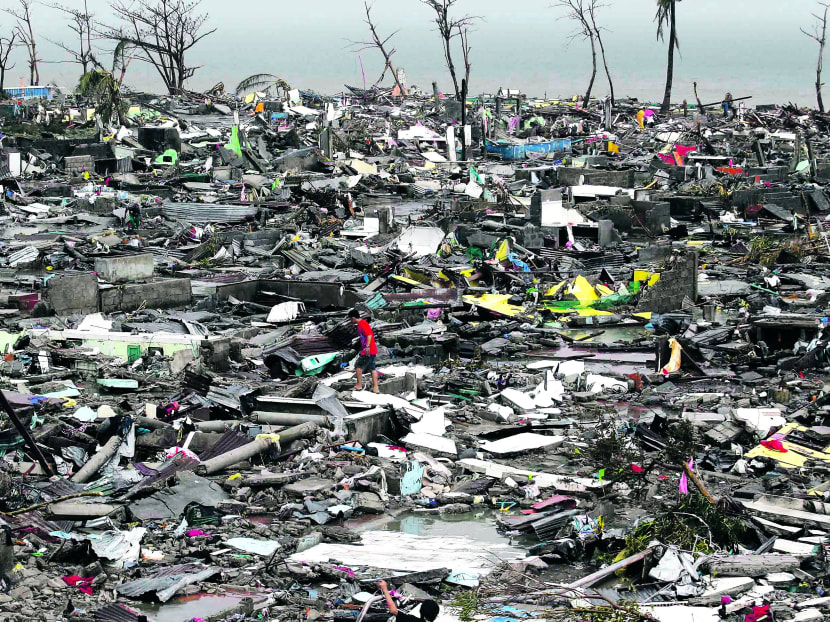Philippines devastated by Typhoon Haiyan
CEBU — One of the most powerful typhoons recorded appears to have devastated cities, towns and fishing villages with heavy loss of life when it played a deadly form of hopscotch across the islands of the central Philippines.

Destroyed houses in Tacloban, in Leyte province in the central Philippines, after the city was hit by Typhoon Haiyan. PHOTO: AP
CEBU — One of the most powerful typhoons recorded appears to have devastated cities, towns and fishing villages with heavy loss of life when it played a deadly form of hopscotch across the islands of the central Philippines.
Barrelling across palm-fringed beaches and ploughing into frail homes, Typhoon Haiyan hit the eastern seaboard of the Philippine archipelago on Friday and quickly barrelled across its central islands before exiting into the South China Sea, packing winds of up to 306kmh and a storm surge that caused seawaters to rise 6m.
Corpses hung from tree branches and were scattered along pavements and among flattened buildings. Large ships were tossed onshore and vehicles were shown piled on top of one another. Low-income neighbourhoods fared especially badly, with virtually no structures left standing except for a few government buildings. Disorder and looting over the weekend compounded the destruction.
“The last time I saw something on this scale was in the aftermath of the Indian Ocean tsunami,” said Mr Sebastian Stampa, head of a United Nations disaster assessment team already on the ground, referring to the 2004 tsunami that devastated parts of Indonesia and 13 other countries.
“This is destruction on a massive scale. There are cars thrown like tumbleweed,” he said.
Offers of disaster relief and aid have begun pouring in from around the world, including from the United States and Singapore.
The first and most vocal city to cry for help over the weekend was Tacloban on Leyte Island, which was also one of the first places hit by the storm. In many other communities along the storm’s track, virtually all communications were cut off.
The typhoon, which appears to be the worst natural disaster in Philippine history, left Tacloban in ruins, as a storm surge as high as 3.9m overwhelmed its streets, with reports saying that most of the houses had been damaged or destroyed in the city of 220,000.
More than 300 bodies have already been recovered, said City Administrator Tecson John S Lim, adding that the toll could reach 10,000 in Tacloban alone.
President Benigno Aquino declared a “state of calamity” in provinces encompassing islands across the breadth of the Philippines. The declaration is devised to release emergency funds from the national coffers.
But those coffers have already been depleted this year by other natural disasters, most notably a 7.2-magnitude earthquake that also struck the middle of the country four weeks ago.
“On the way to the airport, we saw many bodies along the street,” said Philippine-born Australian Mila Ward, 53, who was waiting at the Tacloban airport to catch a military flight back to Manila. She said she passed “well over 100” dead bodies.
Mr Aquino arrived yesterday in Tacloban to meet victims and coordinate rescue and clean-up efforts. Defence Secretary Voltaire Gazmin described a chaotic scene: “There is no power, no water, nothing. People are desperate. They’re looting.”
The lack of clear information about the extent of the damage raised the possibility that other areas could have been hit just as badly as Tacloban, where rescue efforts were being concentrated.
Interior Minister Mar Roxas was quoted by The Philippine Daily Inquirer as saying: “The entire (Tacloban) airport was under water up to roof level.”
Yesterday, the typhoon began turning its deadly force towards central and northern Vietnam, where more than 600,000 people were evacuated, even as meteorologists said the storm had begun weakening from its strength in the Philippines. But as it neared the mainland, it turned north, its eye skirting the Vietnamese coastline.
Aid efforts in the Philippines were complicated by the magnitude of the devastation, as communications systems were shut down. But already, international aid agencies and foreign governments were rushing to despatch emergency teams.
On Samar Island, across the Philippine Sea from Tacloban, an official from the local disaster office said the local death toll was at least 300 people, with 2,000 others missing.
The Social Welfare and Development Office said the storm affected 4.28 million people in about 270 towns and cities spread across 36 provinces in the central Philippines.
Pope Francis led tens of thousands of people at the Vatican in silent prayer for the typhoon victims yesterday. The Philippines has the largest number of Catholics in Asia. AGENCIES






